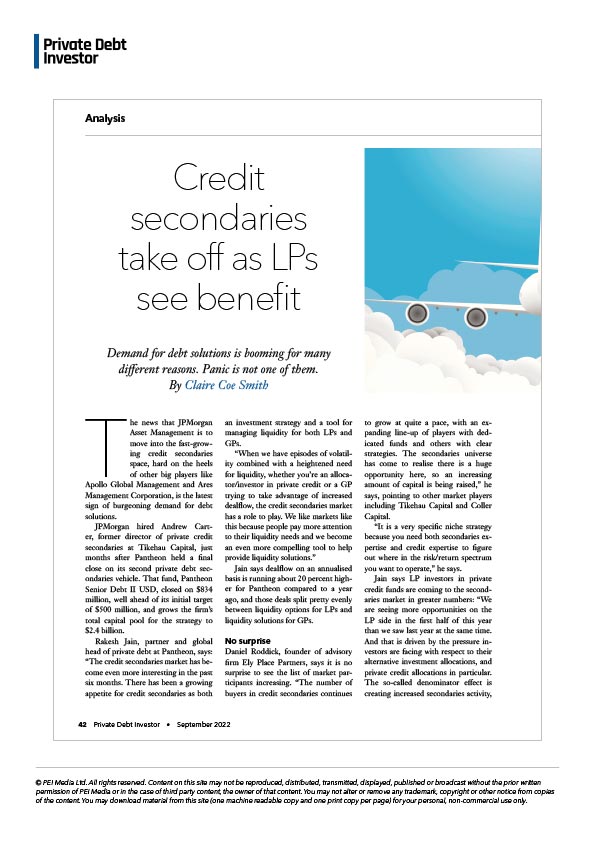Credit secondaries take off as LPs see benefit
Private Debt Investor
Claire Coe Smith
September 2022
Demand for debt solutions is booming for many different reasons. Panic is not one of them.
The news that JPMorgan Asset Management is to move into the fast-growing credit secondaries space, hard on the heels of other big players like
Apollo Global Management and Ares Management Corporation is the latest sign of burgeoning demand for debt solutions.
JPMorgan hired Andrew Carter, former director of private credit secondaries at Tikehau Capital, just months after Pantheon held a final close on its second private debt secondaries vehicle. That fund, Pantheon Senior Debt II USD, closed on $834 million, well ahead of its initial target of $500 million, and grows the firm’s total capital pool for the strategy to $2.4 billion.
Rakesh Jain, partner and global head of private debt at Pantheon, says: “The credit secondaries market has become even more interesting in the past six months. There has been a growing appetite for credit secondaries as both an investment strategy and a tool for managing liquidity for both LPs and GPs.
“When we have episodes of volatility combined with a heightened need for liquidity, whether you’re an allocator/investor in private credit or a GP trying to take advantage of increased deal flow, the credit secondaries market has a role to play. We like markets like this because people pay more attention to their liquidity needs and we become an even more compelling tool to help provide liquidity solutions.”
Jain says deal flow on an annualised basis is running about 20 per cent high- er for Pantheon compared to a year ago, and those deals split pretty evenly between liquidity options for LPs and liquidity solutions for GPs.
No surprise.
Daniel Roddick, the founder of advisory firm Ely Place Partners, says it is no surprise to see the list of market participants increasing. “The number of buyers in credit secondaries continues to grow at quite a pace, with an expanding line-up of players with dedicated funds and others with clear strategies. The secondaries universe has come to realise there is a huge opportunity here, so an increasing amount of capital is being raised,” he says, pointing to other market players including Tikehau Capital and Coller Capital.
“It is a very specific niche strategy because you need both secondaries expertise and credit expertise to figure out where in the risk/return spectrum you want to operate,” he says.
Jain says LP investors in private credit funds are coming to the second- aries market in greater numbers: “We are seeing more opportunities on the LP side in the first half of this year than we saw last year at the same time. And that is driven by the pressure investors are facing with respect to their alternative investment allocations, and private credit allocations in particular. The so-called denominator effect is creating increased secondaries activity, in both private equity and in private credit.”
Ed Goldstein, chief investment officer for Coller Credit Secondaries, points to additional reasons why LPs come to the market: “The reasons for LPs selling in the credit secondaries market are varied – it is not a big dis- tressed sale market and that is not what
we are after. It can be motivated by distress, a change in strategy, the denominator effect, regulatory reasons, accounting reasons, or manager concerns – it really is all over the map.
“We are as busy as we have ever been, and that is not because people are panicking. There are always occasions where someone needs to offload something, but generally what we currently see is not a distressed play. Activity is robust and with volatility that should, if anything, increase. But we will see over the next quarter or two how behaviour changes.”
For credit GPs looking to tap the secondaries market to address tail-end liquidity in legacy funds, or create more diversification or liquidity in existing pools of capital to take advantage of new opportunities on the origination side, the landscape is more nascent but fast evolving. A key difference from other asset classes is that single-asset GP-led deals do not really work in credit, where investors are not looking to take large asymmetric bets and in- stead prefer diverse portfolios.
Roddick says: “There has been such a focus on GP-led secondaries in the private equity market that it is only natural that those would start to be seen in other asset classes. We have seen them in infrastructure and now we are start- ing to see them in private debt. That is early days and there is still a bit of education going on to help GPs appreciate the solutions available.
“In private debt that tends to be a much more bespoke transaction, typically bilateral, because it is usually a portfolio of assets rather than the single assets that we see in private equity deals, and it is about more than simply best price. It is about finding the right buyer that can value the portfolio, which may have some equity or some warrants in it, take a view on the sponsors, value the credit and come up with a solution that works for the credits and the investors.
“Each situation is quite different. It is about finding the right partner to solve whatever issue the GP is addressing.”
Pierpaolo Casamento, head of private debt secondaries at Tikehau Capital in New York, says: “We expect to see a growing volume of GP-led deals in credit because that is going to be a good way for GPs to raise primary capital in this market. They can monetise existing portfolios for the benefit of LPs and bring in capital from second- ary buyers like ourselves. We expect that to be a trend supporting GPs with fundraising going forward.”
Growing familiarity
What is clear is that the growing number of buyers entering credit second- aries is fuelling growth and spreading familiarity with the options available. “What had put people off selling credit was that buyers were pricing to equity returns,” says Goldstein.
“By having folks like us and some of our peers raising dedicated capital for private credit secondaries, it has become less painful for sellers because they are now selling to people pricing closer to credit returns, even if they do have to take a bit of a discount. That was certainly putting people off un- til there was more dedicated capital around that was appropriately costed for the type of risk. Still, there is more education to do.
“The universe of buyers is still pretty small. The number of players with dedicated vehicles is still only a handful. Competition is good as it draws out more sellers and, as deals are getting bigger, we see potential to partner with our peers, so we welcome that. Most of our deal flow is self-originated and the strength and depth of experience in our team is what differentiates us.”
Meanwhile, investors are showing a healthy appetite for credit secondaries funds, with Coller Capital closing its first fund for the strategy at the start of this year with commitments of $1.4 billion. Based on Preqin data at the time, Coller Credit Opportunities I was the world’s largest pool of LP capital dedicated to private credit secondaries, with commitments from more than 30 institutional investors.
Goldstein says: “The current size of the private credit market globally is estimated at $1.2 trillion, according to Preqin, but we think it is closer to $2 trillion because of the many other sources of private credit that sit outside closed-ended funds.
“Less than 1 per cent of that market is currently turning over per year, compared to two or three times that in private equity, so we should easily start to see tens of billions of dollars trading soon. When you consider the pace of growth in the primary market on top of that, we anticipate significant growth in the coming years.”
In addition to that market potential, investors are attracted by the same drivers that bring them into private equity secondaries, including the ability to get capital on the ground instantly, to achieve diversification by vintage, manager and underlying assets, and to touch and feel the assets before they invest.
Jain says: “Some investors were initially sceptical about the willingness of counterparties to transact around credit assets because there is a view that credit is almost always shorter duration than other asset classes in which secondaries have grown significantly.
“However, private credit is still an illiquid asset class and it is still originated and sourced by funds that have seven to 10-year lifespans typically. So, our view is that when liquidity options are brought to an illiquid asset class, compelling investment outcomes can be generated as a result, addressing the interests of both buyers and sellers.”
As the market matures, we may see more specialisation on the buy-side as funds target subsets of the private credit space, favouring senior over junior debt, for example.
Casamento says: “We remain agnostic in terms of sub-strategies within private debt and we look at the whole spectrum, but we are very cautious when it comes to pricing. Because of that, the most interesting opportunities right now are in performing senior credit, which is where we see the most relative value. You are not taking a lot of risk but you can get good pricing, which we haven’t seen so much before.”
For now, there remain plenty of opportunities to go around. Roddick says: “Generally, it is still something of a buyer’s market, because we see new entrants coming in, but it takes a bit of time to raise that capital. It is a young industry that is evolving, so it is going to gradually find that equilibrium. The GPs are educating themselves on the solutions that are out there and the larger institutions are in the process of raising dedicated pools of capital for this strategy.”



